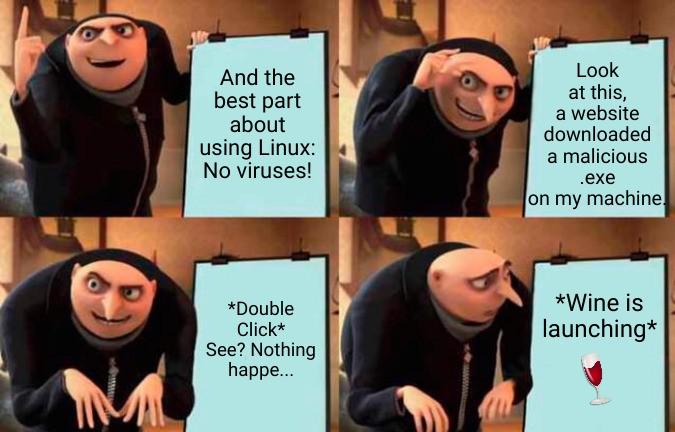this post was submitted on 05 Aug 2023
1968 points (97.3% liked)
linuxmemes
22722 readers
1127 users here now
Hint: :q!
Sister communities:
Community rules (click to expand)
1. Follow the site-wide rules
- Instance-wide TOS: https://legal.lemmy.world/tos/
- Lemmy code of conduct: https://join-lemmy.org/docs/code_of_conduct.html
2. Be civil
- Understand the difference between a joke and an insult.
- Do not harrass or attack users for any reason. This includes using blanket terms, like "every user of thing".
- Don't get baited into back-and-forth insults. We are not animals.
- Leave remarks of "peasantry" to the PCMR community. If you dislike an OS/service/application, attack the thing you dislike, not the individuals who use it. Some people may not have a choice.
- Bigotry will not be tolerated.
- These rules are somewhat loosened when the subject is a public figure. Still, do not attack their person or incite harrassment.
3. Post Linux-related content
- Including Unix and BSD.
- Non-Linux content is acceptable as long as it makes a reference to Linux. For example, the poorly made mockery of
sudoin Windows. - No porn. Even if you watch it on a Linux machine.
4. No recent reposts
- Everybody uses Arch btw, can't quit Vim, <loves/tolerates/hates> systemd, and wants to interject for a moment. You can stop now.
5. 🇬🇧 Language/язык/Sprache
- This is primarily an English-speaking community. 🇬🇧🇦🇺🇺🇸
- Comments written in other languages are allowed.
- The substance of a post should be comprehensible for people who only speak English.
- Titles and post bodies written in other languages will be allowed, but only as long as the above rule is observed.
Please report posts and comments that break these rules!
Important: never execute code or follow advice that you don't understand or can't verify, especially here. The word of the day is credibility. This is a meme community -- even the most helpful comments might just be shitposts that can damage your system. Be aware, be smart, don't remove France.
founded 2 years ago
MODERATORS
you are viewing a single comment's thread
view the rest of the comments
view the rest of the comments

I use Nix, so I’ll just reinstall my system if anything really bad ever happens. Sometimes I reinstall just because. My important files are on a delegate drive I have to manually mount, so I’m not too worried.
Take the next step, and write a simple ansible playbook to configure your installed applications and services. It looks a little complicated at first but it's pretty easy.
Then you just keep your playbook with your other files. When you decide to reinstall, you just install
ansiblethen run it on your playbook. It'll install and set up everything you add to your OS.NixOS really is the next step from an ansible setup like yours imo. It can and usually is a fully declarative and immutable system outside of your nix config and whatever personal files you have.
Yeah, I get that. I'm not about to trust NixOS for my production machines at work and since I already know Ansible it's just as easy for me to manage my home machines the same way.
Of course it’s all personal preference, but I’ve been managing my dot files from the very beginning with nix(home manager). Never tried ansible, but, just like you, don’t really need to, as everything is already set up well in Nix(including all my configs for all my programs).
I only know the Ansible as the intergalactic communication system from Ursula K Le Guins novels, so this comment is too cool to me.
That's almost certainly where it came from. This might be hard to believe, but Linux devs are often huge nerds.
Oh I’m sure, that word isn’t used for a lot of other things. It’s neat how much anarchist and socialist lore is hidden inside of FOOS and Linux tech terminology, including the word Ansible. So refreshing compared to closed source devs unironically naming their products after murderous AI or what have you.
unheard of.
Impossible.
I know it from the Ender's Game series, personally.
Ansible was indeed used by Orson Scott Card in his Ender’s series, about 20 or so years after it was first coined by Le Guin. Funny to think of someone reading such good novels as Ursula’s and still coming out of it a bigoted asshole.
One of the things I learned several years ago was how to set up my HD so that the system and home folder are on different partitions. It isn't terribly hard to do, and every OS installer I've used gives you the option. It's served me very well.
What's the purpose of having system and home folder on different positions?
You can easily install a new system if your system gets borked or you just want a new distro, and you won't lose your files.
I don’t have a need for that atm(like I said, my laptop has a separate drive), but will look into that in case I ever need it in the future. My problem with this personally tho is that I share my drive between Windows and Linux, and Linux doesn’t exactly play well with NTFS. Sounds really cool however for having a multi boot Linux system, with all your files shared between distros.